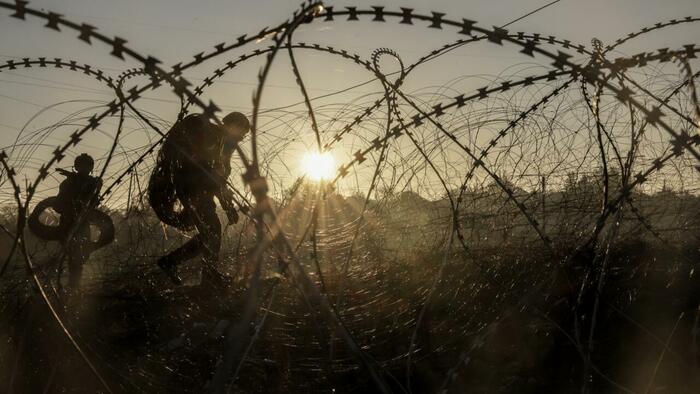As we detailed earlier, the White House is currently overseeing a ‘massive surge’ in arms to Ukraine with just 50 days left before President-elect Trump enters office. The US is also this week announcing $725 million in more aid, which is the latest defense package for Ukraine drawn directly from US inventories.
It will include a second shipment of antipersonnel mines, and comes the same day that Germany also unveiled another $680 million in Ukraine aid. The Western allies have asserted that they want to see Zelensky and Ukraine forces in as favorable a position as possible before negotiations to end the war inevitably proceed (something which Trump has repeatedly promised from day one of his second administration). But the prime question remains: what good will the rapid infusion of more weapons do when the real problem is Ukraine’s collapsing manpower? To illustrate the reality of Russia’s rapid advance of the past several months…
🇷🇺 The Liberation of Donbass.
This map clearly illustrates the rapid advancements of the Russian Armed Forces this fall, as cities and villages in the DPR are being liberated one after another.
Above all, it’s simply remarkable. pic.twitter.com/SlZLsbXibC
— DD Geopolitics (@DD_Geopolitics) November 30, 2024
Below is a round-up of the progression of the Russian advance according to article headlines stretching back more than a month ago to today, illustrating the same.
* * *
Headline from four weeks ago: Ukrainian defenses in Donbas risk getting steamrolled by Russian advance
On the front lines in Donbas, the situation “remains difficult”, Ukraine’s army chief Oleksandr Syrsky said in a Telegram message on November 2. Ukrainian forces there are “holding back one of the most powerful Russian offensives since the beginning of the full-scale invasion”, he added.
A renewed push by Russian forces that began in springtime now seems to be bearing fruit in east Ukraine.
The Russian army advanced 478 km² into Ukrainian territory in October, according to an AFP study analysing data from the American thinktank the Institute for the Study of War. This is the largest advance it has made since the early days of the full-scale offensive in Ukraine in spring 2022.
Headline from two weeks ago: Ukraine front could ‘collapse’ as Russia gains accelerate, experts warn
The ISW data shows Moscow’s forces have seized around 2,700 sq km of Ukrainian territory so far this year, compared with just 465 sq km in the whole of 2023, a near six-fold increase.
Dr Marina Miron, a defence researcher at Kings College London, suggested to the BBC that there was a possibility the Ukrainian eastern front “might actually collapse” if Russia continued to advance at pace.
More than 1000 sq km was taken between 1 September and 3 November, suggesting the push accelerated in recent months. Two areas bearing the brunt of these advances are Kupiansk in Kharkiv region, and Kurakhove, a stepping stone to the key logistical hub of Pokrovsk in Donetsk region.
Headline from one week ago: Ukraine War Map Reveals Russia’s Rapid Front Line Advances
Russian forces have been advancing far more quickly in Donetsk region in recent weeks than they did for the whole of last year, according to the Institute for the Study of War (ISW), whose map shows the state of play on the front line.
The Washington, D.C., think tank said on Sunday that recent Russian gains near Vuhledar and Velyka Novosilka showed that the war “is not stalemated” and the Donetsk region is “becoming increasingly fluid” with the latest Russian advances. Newsweek has emailed the Russian and Ukrainian defense ministries for comment.
Russian forces have seized settlements northeast of Vuhledar and advanced north of the town they had captured in October, according to Ukrainian sources and geolocated footage.
Headline from two days ago: Russia Forges Ahead in Eastern Ukraine, Capturing More Villages in Recent Days
Russian troops in eastern Ukraine have seized at least 10 villages and settlements in roughly as many days, according to a group with ties to the Ukrainian Army that maps the battlefield, as Moscow presses on with slow but steady advances that have heightened pressure on Ukraine’s authorities to start cease-fire talks.
The situation looks particularly precarious for Ukrainian forces in Donetsk, in Ukraine’s east, where Russian forces are closing in on their last two strongholds in the southern part of the region, according to the analysis by the group, DeepState. The fall of the strongholds, Kurakhove and Velyka Novosilka, could pave the way for a Russian takeover of the area, experts say.
Russia, which annexed Donetsk in 2022 and controls about two-thirds of the region, is seeking to consolidate power over the whole territory.
Headline from today (Monday): ‘Major compromise’: How Ukraine’s Zelenskyy shifted goals to end Russia war
President Volodymyr Zelenskyy said over the weekend that he seeks an early end to the war with Russia, adding Ukraine could retake occupied land later through diplomacy if Kyiv’s NATO membership is certain.
This marks a shift from his earlier stance, where he said the end of the war was contingent on Russia returning seized Ukrainian territory.
* * *
Russia could see itself in such a position as to not need negotiations at this point. If the two sides two sit down at the table to seek ceasefire, the terms will without doubt be fully in Moscow’s favor. With Russia winning on the battlefield in the east in this tragic war of attrition, the Kremlin is unlikely to want to “give up” anything at all. Compromise and territorial concessions will be on the Zelensky government’s shoulders.
Loading…
Read the full article here

